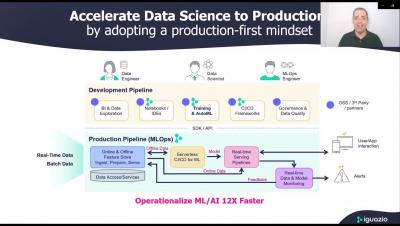Systems | Development | Analytics | API | Testing
Iguazio
Automating MLOps for Deep Learning
ODSC West: Building Operational Pipelines for Machine and Deep Learning
ODSC West AI Expo Talk: Real-Time Feature Engineering with a Feature Store
ODSC West MLOps Keynote: Scaling NLP Pipelines at IHS Markit
Introduction to TF Serving
Machine learning (ML) model serving refers to the series of steps that allow you to create a service out of a trained model that a system can then ping to receive a relevant prediction output for an end user. These steps typically involve required pre-processing of the input, a prediction request to the model, and relevant post-processing of the model output to apply business logic.
It Worked Fine in Jupyter. Now What?
You got through all the hurdles getting the data you need; you worked hard training that model, and you are confident it will work. You just need to run it with a more extensive data set, more memory and maybe GPUs. And then...well. Running your code at scale and in an environment other than yours can be a nightmare. You have probably experienced this or read about it in the ML community. How frustrating is that? All your hard work and nothing to show for it.
How to Bring Breakthrough Performance and Productivity To AI/ML Projects
By Jean-Baptiste Thomas, Pure Storage & Yaron Haviv, Co-Founder & CTO of Iguazio You trained and built models using interactive tools over data samples, and are now working on building an application around them to bring tangible value to the business. However, a year later, you find that you have spent an endless amount time and resources, but your application is still not fully operational, or isn’t performing as well as it did in the lab. Don’t worry, you are not alone.










